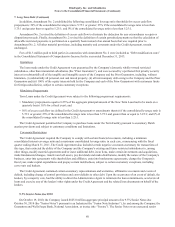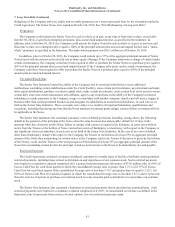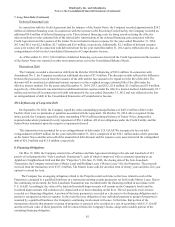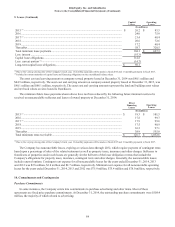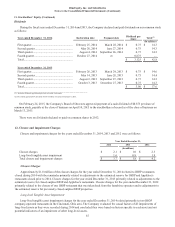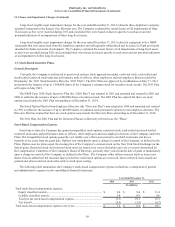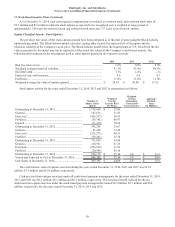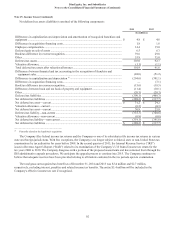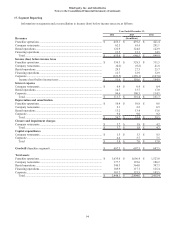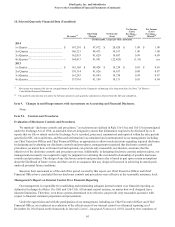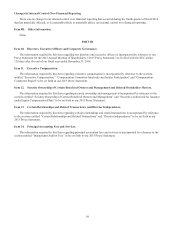IHOP 2014 Annual Report Download - page 107
Download and view the complete annual report
Please find page 107 of the 2014 IHOP annual report below. You can navigate through the pages in the report by either clicking on the pages listed below, or by using the keyword search tool below to find specific information within the annual report.
DineEquity, Inc. and Subsidiaries
Notes to the Consolidated Financial Statements (Continued)
12. Closure and Impairment Charges (Continued)
88
Long-lived tangible asset impairment charges for the year ended December 31, 2013 related to three Applebee's company-
operated restaurants in the Kansas City, Missouri area. The Company evaluated the causal factors of all impairments of long-
lived assets as they were recorded during 2013 and concluded they were based on factors specific to each asset and not
potential indicators of an impairment of other long-lived assets.
Long-lived tangible asset impairment charges for the year ended December 31, 2012 related to equipment at five IHOP
restaurants that were taken back from the franchisee operator and subsequently refranchised and to a parcel of land previously
intended for future restaurant development. The Company evaluated the causal factors of all impairments of long-lived assets
as they were recorded during 2012 and concluded they were based on factors specific to each asset and not potential indicators
of an impairment of other long-lived assets.
13. Stock-Based Incentive Plans
General Description
Currently, the Company is authorized to grant stock options, stock appreciation rights, restricted stock, cash-settled and
stock-settled restricted stock units and performance units to officers, other employees and non-employee directors under the
DineEquity, Inc. 2011 Stock Incentive Plan (the “2011 Plan”). The 2011 Plan was approved by stockholders on May 17, 2011
and permits the issuance of up to 1,500,000 shares of the Company’s common stock for incentive stock awards. The 2011 Plan
will expire in May 2021.
The IHOP Corp. 2001 Stock Incentive Plan (the “2001 Plan”) was adopted in 2001 and amended and restated in 2005 and
2008 to authorize the issuance of up to 4,200,000 shares of common stock. The 2001 Plan has expired but there are stock
options issued under the 2001 Plan outstanding as of December 31, 2014.
The Stock Option Plan for Non-Employee Directors (the “Directors Plan”) was adopted in 1994 and amended and restated
in 1999 to authorize the issuance of up to 400,000 shares of common stock pursuant to options to non-employee directors. The
Directors Plan has expired but there are stock options issued under the Directors Plan outstanding as of December 31, 2014.
The 2011 Plan, the 2001 Plan and the Directors Plan are collectively referred to as the “Plans.”
Stock-Based Compensation Expense
From time to time, the Company has granted nonqualified stock options, restricted stock, cash-settled and stock-settled
restricted stock units and performance units to officers, other employees and non-employee directors of the Company under the
Plans. The nonqualified stock options generally vest ratably over a three-year period in one-third increments and have a
maturity of ten years from the grant date. Options vest immediately upon a change in control of the Company, as defined in the
Plans. Option exercise prices equal the closing price of the Company's common stock on the New York Stock Exchange on the
date of grant. Restricted stock and restricted stock units are issued at no cost to the holder and vest over terms determined by
the Compensation Committee of the Company's Board of Directors, generally three years from the date of grant or immediately
upon a change in control of the Company, as defined in the Plans. The Company either utilizes treasury stock or issues new
shares from its authorized but unissued share pool when vested stock options are exercised, when restricted stock awards are
granted and when restricted stock units settle in stock upon vesting.
The following table summarizes the Company's stock-based compensation expense included as a component of general
and administrative expenses in the consolidated financial statements:
Year Ended December 31,
2014 2013 2012
(In millions)
Total stock-based compensation expense:
Equity classified awards............................................................................. $ 9.4 $ 9.4 $ 11.4
Liability classified awards.......................................................................... 2.4 0.9 4.8
Total pre-tax stock-based compensation expense ...................................... 11.8 10.3 16.3
Tax benefit.................................................................................................. (4.5) (3.9) (6.2)
Total stock-based compensation expense, net of tax ...................................... $ 7.3 $ 6.4 $ 10.1




